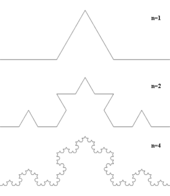
Fractal-generating software is any type of graphics software that generates images of fractals. There are many fractal generating programs available, both free and commercial. Mobile apps are available to play or tinker with fractals. Some programmers create fractal software for themselves because of the novelty and because of the challenge in understanding the related mathematics. The generation of fractals has led to some very large problems for pure mathematics.[1]
Fractal generating software creates mathematical beauty through visualization. Modern computers may take seconds or minutes to complete a single high resolution fractal image. Images are generated for both simulation (modeling) and random fractals for art. Fractal generation used for modeling is part of realism in computer graphics.[2] Fractal generation software can be used to mimic natural landscapes with fractal landscapes and scenery generation programs. Fractal imagery can be used to introduce irregularity to an otherwise sterile computer generated environment.[3]

Fractals are generated in music visualization software, screensavers and wallpaper generators. This software presents the user with a more limited range of settings and features, sometimes relying a series pre-programmed variables. Because complex images can be generated from simple formula fractals are often used among the demoscene.[4] The generation of fractals such as the Mandelbrot set is time-consuming and requires many computations, so it is often used in benchmarking devices.[5]
- ^ Frame, Michael; Amelia Urry (2016). Fractal Worlds: Grown, Built, and Imagined. Yale University Press. p. 129. ISBN 978-0300197877. Retrieved 5 May 2017.
- ^ F. v., Haeseler v.; H.-O Peitgen; G. Skordev (2012). "Linear Cellular Automata, Substitutions, Hierarchical Iterated Function Systems and Attractors". In Encarnacao, Jose L.; Peitgen, Heinz-Otto; Sakas, Georgios; Englert, Gabriele (eds.). Fractal Geometry and Computer Graphics. Springer Science & Business Media. p. 3. ISBN 9783642956782. Retrieved 7 May 2017.
- ^ Cite error: The named reference
tciwas invoked but never defined (see the help page). - ^ Janus Kopfstein (14 May 2014). "This 4-kilobyte demo squeezes a universe of fractals into the size of a Word document". The Verge. Vox Media. Retrieved 5 March 2017.
- ^ Malyshkin, Victor (2013). Parallel Computing Technologies: 12th International Conference, PaCT 2013, St. Petersburg, Russia, September 30-October 4, 2013, Proceedings. Springer. p. 267. ISBN 9783642399589. Retrieved 7 May 2017.